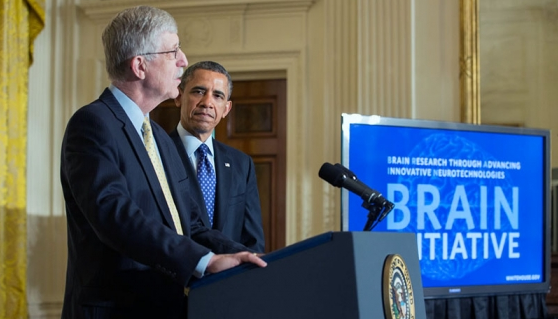On April 10th, President Obama will finally release his 2014 budget proposal. The budget has been delayed two months due to uncertainties regarding the fiscal cliff and sequestration, but I think it will ultimately be well worth the wait. Within this budget, it seems, could be a game changer not only for the American economy but also for the scientific world: the Brain Research through Advancing Innovative Neurotechnologies (BRAIN) Initiative.
Basically, the BRAIN Initiative, also known as the Brain Activity Map Project, would be an effort to give scientists a dynamic representation, a “map,” of the electrical activity of hundreds of millions of neurons in the brain. Researchers could ideally use this map, as President Obama alluded to in his State of the Union address, to confront the mysteries of Alzheimer’s, Parkinson’s, schizophrenia, and autism. Stemming from an interdisciplinary meeting between neuroscientists and nonscientists in 2011, the project’s crux is the proposed use of nanotechnology to record brain activity that neuroscientists have not, without sophisticated enough technology, been able to record.
The Obama administration has been explicitly comparing the BRAIN Initiative to the Human Genome Project, which, for its part, has had a lot of bang for its buck: by Obama’s estimates, for every $1 put invested in the Human Genome Project, America got $140 in returns. Fittingly, Francis S. Collins, Director of the National Institute of Health (NIH) and leader in the Human Genome Project, is organizing the BRAIN Initiative. But critics argue that while the Human Genome had very specifics parameters, the Brain Activity Map has no bounds; because the brain is so complex, there is no way of telling when the work is “done.”
But Francis S. Collins explains that that critique misses the point: “To understand how the human brain works is about the most audacious scientific project you can imagine…five years ago this might have seemed out of reach. Five years from now it will seem like we waited too late to take advantage.” Basically, Collins is saying that because of the plethora of new and promising recording technologies available, the BRAIN Initiative has a real chance of making promising strides for science. As President Obama put it on April 2nd, “humans…still haven’t unlocked the mystery of the three pounds of matter that sits between our ears…As a result, we are still unable to cure diseases like Alzheimer’s…The BRAIN Initiative will change that by giving scientists the tools they need to get a dynamic picture of the brain in action, and a better understanding of how we think, how we learn, and how we remember…that knowledge will be transformative.”
The cost of the Initiative for 2014? $100 million. And if approved, Obama’s proposal will amount to 10 years of research that could ultimately cost around $3 billion. But if even one doesn’t buy, like NYU Professor Gary Marcus, that the President’s comparison between the Human Genome Project and the Brain Activity Map is sound, all agree there is an unquestionable value to the science. Especially when NIH is expected to see $85 billion in cuts in the next few years, any funds are welcomed in the scientific community.
At the end of the day, there is no way of knowing whether the research will pan out in the ways that proponents, or critics, expect it to. Considering how miniscule the budget is for this project, however, it seems that the potential rewards for this endeavor, like those for the Human Genome Project, way overvalue the risks.

RT @MattIanMcCabe: @BrownBPR’s Dan Kopin about scientists coming after your delicious brains…but only for study: http://t.co/MniUawZJf …
@BrownBPR’s Dan Kopin about scientists coming after your delicious brains…but only for study: http://t.co/MniUawZJfc #missingwalkingdead